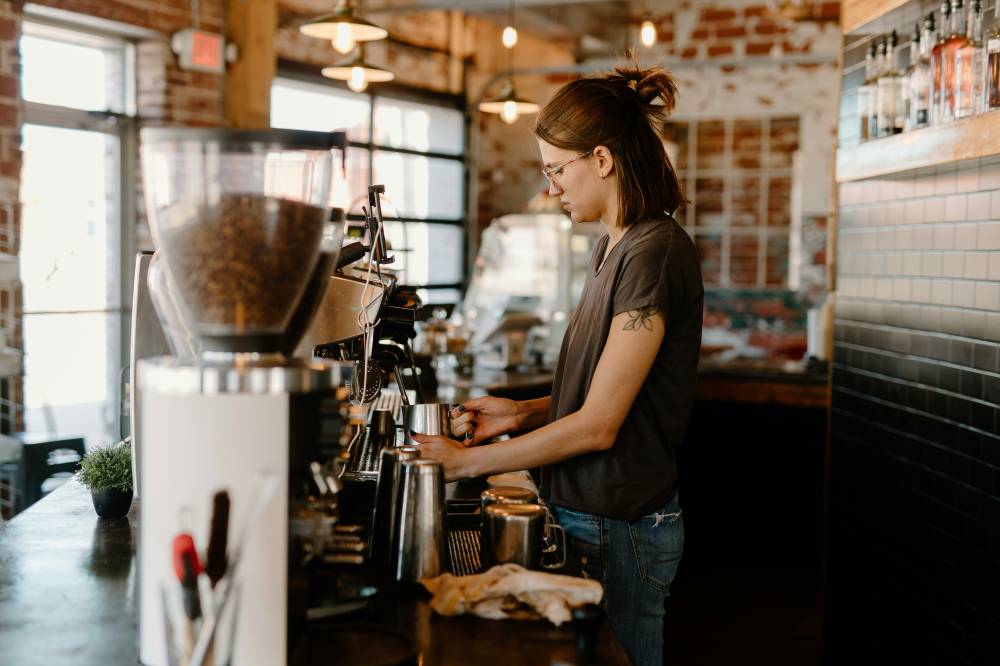So you want to start a coffee shop? Here’s what you need to know

Coffee is a popular drink that many aspiring business owners want to tap into. And while it can be lucrative, especially in high-traffic areas or with a strong brand, it’s not a guaranteed cash cow. Thin margins, fierce competition, and steep overhead costs can eat into profits—fast.
After all, running a coffee shop is more than just curating picture-perfect drinks, brewing beans, adding syrups and cream, serving them hot or iced, and watching the customers roll in.
“There’s a very romantic notion in owning a coffee shop—having a cozy place with regulars, good coffee, and a very chill vibe,” Tuesday Angliongto, of Pocofino begins. “But I think it’s a mistake to think that running a coffee shop is easier than running any other F&B business.”
“A coffee shop is still a business. And it should be considered as such, even if it’s a passion project or an additional business for you,” she emphasizes.
Coffee culture in the Philippines
With fertile land and an ideal climate for growing beans, there is no doubt: coffee is a beloved drink in the Philippines. But from being the world’s fourth-largest coffee producer and exporter in the 18th century to suffering a devastating coffee rust epidemic in the 19th century, the country’s coffee industry has seen its share of highs and lows.
Thanks to dedicated farmers and a renewed interest in local beans, however, the 20th century marked the beginning of a slow but steady revival, with dedicated farmers who revived old coffee varieties and implemented sustainable practices that yielded better-quality coffee beans. And with it came a growing appreciation for flavor and nuance, as coffee aficionados worked to educate and elevate the local market, which can be seen even today.
“It seems like everyone has a coffee shop these days, which is interesting, because this helps level up the knowledge and taste of the public,” Angliongto notes. “There is also a demand for it as coffee consumption keeps growing.”
Whether it was the aftermath of the pandemic, the boom of online businesses, or viral internet trends that sparked “home cafés” and DIY drinks, one thing became clear: Filipinos weren’t just drinking coffee—they were embracing a full-on coffee culture.
Location, location, location
Before even starting your own coffee shop, it’s important to first know what you’re getting into. “Be ready to work hard to create that cozy, chill, or cool coffee shop of yours. But more importantly, look for reliable suppliers before anything else,” Angliongto says.
“Aside from your business plan and your products, location is probably the most important factor for your business—especially for your first branch,” she continues. “This will be your introduction to the public about who you are and who you want to be. In a practical sense, being in a good location creates less work.”
But what makes a good location? According to the coffee shop owner, it all boils down to your goals and your business plan.
“Of course, the fundamental aspect that makes a location good is the foot traffic,” Angliongto shares. “You want the right people to pass by your business. This doesn’t necessarily mean most people (though in general, more is better when it comes to foot traffic), because that won’t matter if they’re not the right people for you.”
The coffee shop owner notes, however, a common mistake: that business owners set up shop far away from their competitors.
“If you’re confident in your business and have something unique to offer, see where your competitors set up shop and try to be near them—they may know something about the area that you don’t,” she advises.
But this isn’t optimal for everyone, she adds, since being far away from them will make people come to your shop instead. “This isn’t impossible, [though] it’s just not as easy as being in a location that has natural activity,” Angliongto opines.
But the non-negotiable no-no in choosing a location? Choosing “an area with rent that’s too high for your operations to cover feasibly, or one that’s cheap but puts you in the wrong location.”
“You may be saving on rent cost, but the hidden cost is you lose out on opportunities—like better foot count,” she warns. “Know your numbers well. It’s not enough to have profit. You need to plan when you’ll make a return on your investment.”

The customer experience
Opening a coffee shop, like any other business, means understanding your market. Filipino customers are, for the most part, “very forgiving and prone to giving feedback to help your store.”
“A common mistake that your customers will see instantly is if your staff isn’t friendly and accommodating,” Angliongto points out. “Your coffee shop could be falling apart (hopefully not), but if you have a staff that knows how to speak to the customer and make them comfortable, you will always have the opportunity to win them over.”
That being said, Angliongto notes the importance of setting up your coffee shop as “the place between home and work,” which was popularized by the coffee chain, Starbucks.
She adds that, “This is a delicate balance the owner must consider when training their staff—making it a place where people want to meet and catch up, yet at the same time being efficient, so that the space is always ready for the next set of customers.”
But this doesn’t mean that you need to kick out your customers. It means building an experience that makes them want to come back—from “making sure that your products are good, your staff is friendly, and [that] the ambiance of your cafe is distinctive.”
It’s just as important to understand the behavior of your market. Filipinos, for example, are social people. “While a lot of people who will stay in the coffee shop will be alone, there are a lot of group orders for takeout or delivery, so you should prepare to have solutions for how to transport this securely,” she observes.
Another thing to consider? A good number of Filipinos prefer their coffee sweet, iced even, given our climate. While this is common in the Southeast Asian market, Angliongto stresses that coffee shops need to “have at least one unique blockbuster sweet iced coffee on your menu to appeal to that taste,” while adding that “this must be balanced, as Filipinos want to still taste the coffee in their beverage.”
Having a consistent supply chain
Supplies are the lifeblood of every coffee shop, and Angliongto knows that for a fact. And amid the search for the best supplier, she notes that a reliable one is a much better one.
“A common mistake is to get a supplier who isn’t consistent with their stocks,” she cautions. “You need to find someone who can provide your ingredients consistently. This may not be possible all the time, so it’s best to have several approved backup suppliers to make sure your operations run smoothly.”
“Your coffee beans will be the core of your business. Decide what kind of coffee shop you want to be and what you want to specialize in so you can look for the right beans for you,” she adds.
This means finding coffee beans that “won’t get lost in all the other ingredients,” given that the Filipino market primarily consumes sweet iced coffee drinks. And yes, that can mean having different beans for different drinks—whether it’s for black coffee, latte, and/or your flavored drink options.
Another important factor?A supplier with whom you can build a good rapport with.
“There can be companies who will have a take it or leave it attitude with you as a small business owner, so I wouldn’t put all my eggs in their basket if they’re not treating you well while you’re starting out,” Angliongto says. “Keep them cause you will always need suppliers, but don’t make them your main one. There are good suppliers out there who are deserving of your time.”
This becomes critical when external factors—like rising import costs and unstable supply chains—start to affect both profit margins and your supply chain.
“Shipping costs are on the rise and we’re seeing more price fluctuations on our goods,” the coffee shop owner laments. “Coffee beans are also becoming more and more expensive because of the low yield of green bean robusta harvests and the growing demand for it. While the growing beans locally will help drive down costs, the supply isn’t consistent enough. This means increased costs for your business.”
Given this, Angliongto says to plan ahead. “Make sure your cost structures account for that fluctuation. This may mean pricing things higher to make sure you won’t be adjusting your prices for your customers too often.”

Myths and misconceptions of having a small business
Referencing and comparing ourselves to existing coffee shops and chains is normal, but Angliongto cautions against following their playbook. After all, a small coffee shop cannot be on par with a chain of coffee shops, as they have been around for much longer—plus, they “have access to supply chains and volumes that new businesses don’t.”
“If you’re using big coffee shops as a benchmark, it should be done mindfully,” she says. “Maybe you don’t want to be a huge company. Maybe you want less than 10 shops and that’s what success looks like to you. That’s okay. Just look at them for best practices (products, service, business models) and adapt that to your business.”
Small coffee shops, while seemingly underdogs in the playing field, actually have the ability to pivot quickly, while targeting specific communities, Angliongto says. What’s more, owners have more leverage to “define what your shop is without having to answer to bigger corporations.”
Her advice? “Look beyond what makes a fundamental coffee shop—that is, serving coffee and food—and explore. A lot of enterprising coffee shops now take it a step further and position themselves as community centers. This may be particular to Manila and big cities but people look for places to commune and socialize.”
Angliongto also recommends leveraging the flexibility of your space in order to cross-market and eventually widen your net of potential customers. Collaboration is the name of the game in today’s business landscape, and as a small business owner, you can easily tap into that.
“If you want to hop on cultural trends, for example, creating sudden promos in response to something happening in pop culture, you can do that right away,” she says. “You can be as on the pulse as you want…[and] you don’t need to directly compete with the big guys because you can create your own space and market.”
Advice for aspiring coffee owners
So how can a coffee shop succeed in a saturated market? It all begins with dispelling the myth that a coffee shop is easy to put up. While it could be a low capital venture, as “all you really need is a coffee machine (though you may not need that if you focus on coffee brewing methods that don’t need a machine, like drip coffee), refrigerators, and the store itself,” it takes grit, hard work, and business savvy to keep it afloat—like every other business.
But more than that, it takes knowing your business.
“A common mistake for first-time business owners is not knowing industry standards that will help them assess if they’re running their business efficiently,” Angliongto points out. “You don’t need to reinvent the wheel. Ask around and know how much your rent should cost, your cost of goods, etc. Most people in food and beverage would share this kind of general information to at least point you in the right direction.”
“Know what’s ‘competitive,’” she continues. “Sometimes, when we focus on being competitive, we immediately assume that means we have to be cheap. Of course, that’s one model that works, [though] it would mean having tighter margins and a bigger need for high volume. But to be competitive, practically speaking, means to have pricing that makes sense within your market.”
This is why it’s important to know how you want to position yourself as a business. After all, it may be tempting to price your drinks higher for bigger profit margins, but this isn’t something the market will readily accept. It can also be telling about your operations.
“If you have a higher cost than this average, you need to investigate where it’s coming from,” Angliongto warns. “Is it wastage? Are you using suppliers that are too expensive for how you want to price your products? Are you pricing too low considering your costs? Note that you can have a range of products. Some are high margin, [while] some are loss leaders.”
But ultimately, the sustainability of your business depends on whether your business model works. This is why Angliongto says to ask yourself: “Have you returned on investment, or are you on schedule to return on investment? Do you have a consistent number of customers and sales that sustains daily operations? Are you making profit? Are your costs manageable?”
For the coffee shop owner, it’s more reassuring to see that your coffee shop is secure before branching out. But even if you’re in the red, it’s not the end of the world just yet.
“You’re always free to reassess your business plan and goals for your business. Knowing this will make it easier to make decisions,” she ends.





















